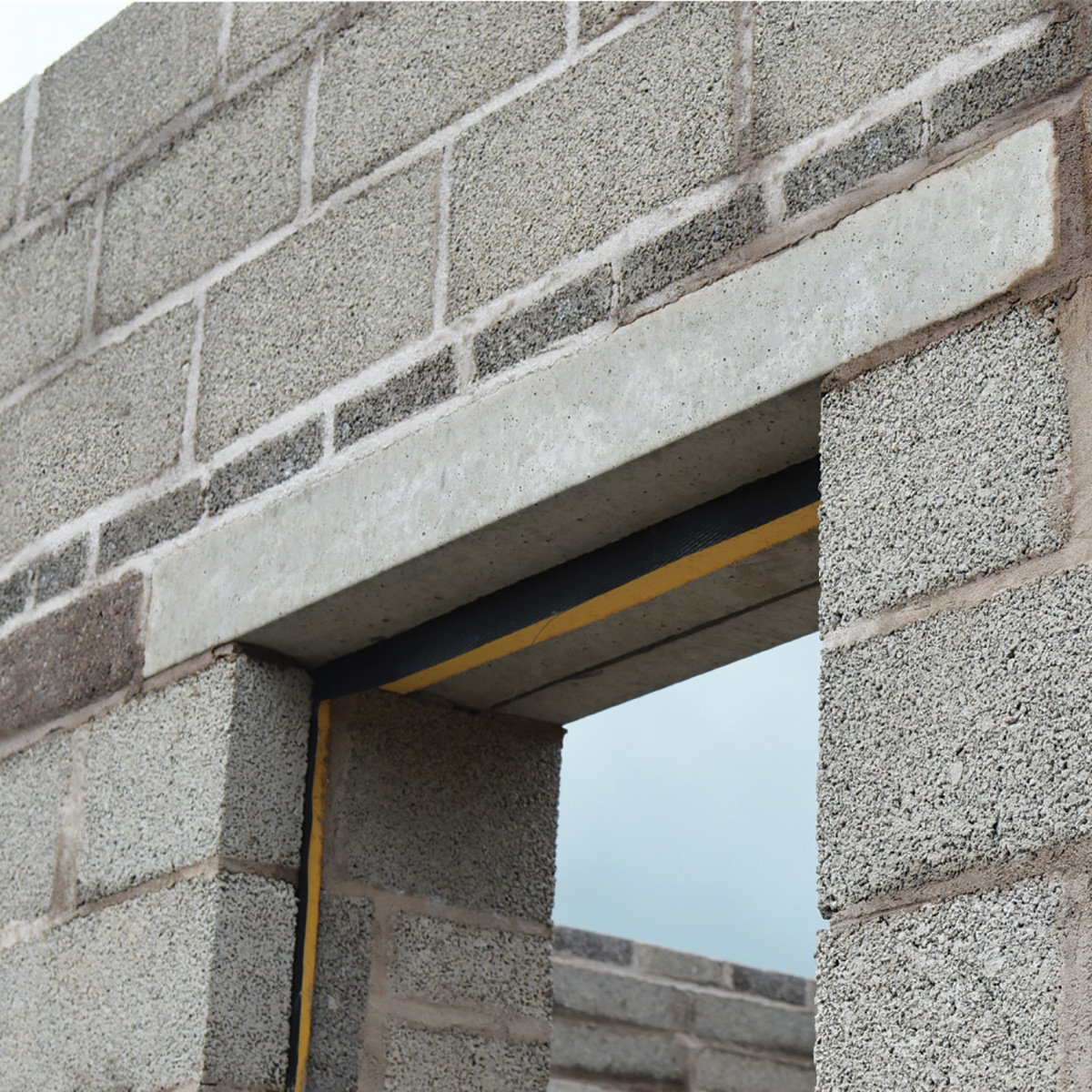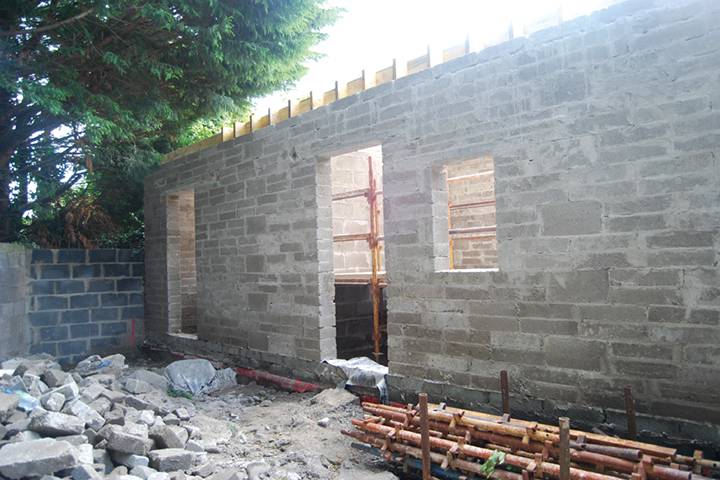Blockwork remains the most common building method in the UK today.
In this article we cover:
- What is masonry construction, and what does blockwork involve?
- The cost of building with blockwork: What to expect
- Pros and cons of using blockwork in construction
- Understanding brickwork and how to feature it in your self-build
- Concrete block varieties and choosing the right mortar strength
- A guide to stonework and how to include it in your self-build project
- Lintels explained: What they are and how to use them effectively
From the majestic pyramids of ancient Egypt to today’s self-built family homes, masonry has been the backbone of construction for centuries. At its core, masonry refers to the process of assembling structures from small, individual units, typically bonded together using mortar.
These units can be made from a variety of materials, including brick, stone, clay, concrete, granite, limestone, and cast stone. In the UK, brick and block are the most commonly used types. Once laid and bonded, these units can serve a structural purpose — supporting loads — or simply act as a decorative outer layer.
Concrete blocks, like all forms of masonry, are excellent at withstanding compressive forces but much less effective in tension. This makes reinforcement necessary in certain conditions, especially for large, flat wall surfaces exposed to strong winds or ground movement.
[adrotate banner="58"]Reinforcement can be added by inserting steel bars both vertically and horizontally, or by filling hollow blocks with concrete. Strength and stability can also be improved by adding buttressing piers at regular intervals.
Although masonry is often chosen for its structural durability, it’s also frequently used as a cladding material over timber-framed buildings. Many timber frame homes, for instance, feature brick or stone finishes for added visual appeal and protection
Due to its weight, masonry requires a solid base — typically a reinforced concrete foundation — to ensure stability. Unlike more flexible materials such as timber, masonry does not accommodate movement easily.
To minimise cracking, long masonry walls should include vertical expansion joints. For blockwork, these are usually spaced every 6 metres; for brickwork, every 12 metres is typical.
Attention to mortar strength is also crucial. A mix that’s too strong may lead to cracking, while one that’s too weak can deteriorate over time, allowing moisture to seep through the joints.
Blockwork advantages
Durability
Some Roman masonry structures are still standing strong over 2,000 years later. Masonry is naturally resistant to rot, decay, moisture, UV exposure, corrosion and infestation.
Sound insulation
Thanks to their dense structure, masonry walls provide excellent acoustic performance, helping to block out unwanted noise.
Fire resistance
Non-combustible by nature, masonry offers inherent protection against fire — an obvious advantage in any build.
Thermal mass
Masonry materials like concrete absorb heat during the day and gradually release it when temperatures drop, helping to stabilise indoor temperatures — like a whole-house heat store.
Flood resilience
In flood-prone areas, masonry can be designed to withstand water exposure. Once dried out, it typically regains its original strength with little to no lasting damage.
Energy efficiency
Aerated concrete blocks, in particular, offer impressive U-values, contributing to a well-insulated, energy-efficient home.
Mortar mix matters
Using the right mortar strength is crucial — too strong and cracks may appear; too weak and the joints can weather prematurely, allowing water ingress.
Skilled labour availability
Because masonry is so widely used in UK homebuilding, most contractors have experienced tradespeople on hand who are well-versed in the technique.
Readily available materials
Many masonry products are locally produced and easy to source from nearby builders’ merchants — a big plus if you run short during construction.
Flexible for future changes
Masonry construction makes extensions and alterations straightforward — ideal in today’s world, where adapting an existing home often makes more sense than moving.
Proven and trusted
As the most common construction method in the UK, masonry has a strong track record. Builders are familiar with it, and it’s widely accepted by lenders, insurers, and warranty providers.
Recyclable
At the end of a building’s life, many masonry materials can be reused — bricks can be reclaimed and cleaned, while concrete can be crushed for new applications.
Blockwork disadvantages
Slow construction pace
Masonry involves assembling small units, which makes it inherently time-consuming. Using larger concrete or stone blocks can speed up construction, but their weight can make handling harder and slow progress.
Sensitive to extreme weather
Masonry doesn’t respond well to harsh climates, particularly frost. Water infiltration followed by freeze-thaw cycles can cause gradual damage over time. While pointing between bricks or stones may look decorative, its main role is to seal out water. Wet or cold weather can also delay progress on site, as new masonry work needs protection from the elements.
Heavyweight material
Although the weight of masonry contributes to its strength, it also demands substantial foundations, which can be costly. In a sustainability-focused world, lighter alternatives like timber — which can be built on micro-piles or minimal foundations — present a more eco-friendly option.
Environmental impact
The production of concrete has a notable environmental footprint, from the quarrying of raw materials to the high energy and CO₂ emissions involved in its manufacture.
Challenging on-site storage
Masonry units are bulky and fragile, requiring careful storage on site — ideally in dry conditions. Damaged bricks or broken blocks are unusable, making protection and handling key.
Needs skilled workmanship
Because masonry is assembled piece by piece, it offers flexibility in design but demands experienced labour. When used as a finished surface — such as exposed brick or stone — it must be installed with great care and precision, which adds to the cost. Masonry sites, being exposed to the elements, are vulnerable to delays. Skilled trades are also essential for achieving airtight construction, with all joints properly filled and airtightness measures properly implemented.
Limited tolerance for movement
Masonry structures aren’t ideal in areas with poor ground conditions, where solid foundations are difficult to achieve, or in regions prone to seismic activity. Their rigidity means they don’t cope well with ground movement or vibrations. They simply don’t tolerate movement and crack easily.
Brickwork
While many people think of bricks as simply a decorative exterior finish, they can also serve a structural purpose in internal walls. Their compact size makes them especially suitable for curved or non-standard wall shapes.
Traditionally made from clay, bricks can also be produced using concrete and are available in hundreds of colours and finishes. The final appearance depends heavily on the type of clay used and how it’s fired during manufacturing.
In bricklaying, horizontal units are called ‘stretchers’, while bricks laid perpendicular to the wall are known as ‘headers’. Each horizontal row is referred to as a ‘course’, and the pattern in which these elements are arranged — called the bond — can significantly affect both the look and the strength of the wall. For example, vertically staggered bonds are structurally stronger and less prone to cracking than aligned ones.
Bricks come in various sizes, but all are designed to fit comfortably in a mason’s hand and can be easily cut when needed. For situations that require high compressive strength, such as below ground level, ‘engineering bricks’ are often used. These are denser and stronger than standard bricks.
Brick veneers on external walls are typically attached to the inner structural wall using steel ‘wall ties’, which are spaced and installed according to building regulations. These ties help keep the entire wall structure stable and secure.
Cavity wall construction
A cavity is intentionally left between the two skins of a wall to prevent moisture from penetrating the inner structure. This gap can be partially or fully filled with insulation. Care must be taken during construction to prevent mortar from bridging the cavity by falling onto the wall ties, which can create thermal bridges and allow moisture transfer. It’s important to clean off any mortar from ties at the end of each workday.
At the base of the outer brick skin, ‘weep holes’ are typically inserted to allow any water that enters the cavity to drain out. Mortar should be kept off the inner faces of both wall skins so that insulation boards can be correctly fitted. In addition, ‘cavity trays’ with stop ends and weep holes must be installed above any structural openings (like windows or doors) and wherever services penetrate the wall.
Concrete blocks
There are three primary types of concrete block used in construction:
- High-density blocks – Made from cement mixed with stone or gravel aggregate, these are the standard structural blocks used in load-bearing applications.
- Lower-density blocks – Produced using cement and industrial by-products such as fly ash, these offer better thermal performance and are lighter than high-density versions.
- Lightweight blocks, including autoclaved aerated concrete (AAC) – These are easy to handle, simple to cut, and have excellent thermal insulation properties. Some types are made from up to 80 per cent recycled material, making them an environmentally friendly option.
Blocks typically measure 440mm x 215mm x 100mm, but larger, solid or hollow options exist. Blocks are usually laid on their narrow edge but can be laid flat to form a strong wall where pouring concrete isn’t possible.
While masonry is often chosen for its structural strength, it can also be used as a non-structural veneer. For instance, timber-framed homes are frequently clad in brick or stone to achieve a traditional aesthetic without compromising the lightweight frame.
Advantages of concrete blockwork
One of the key benefits of concrete blocks is their size — they cover more area than bricks and therefore speed up construction. Many concrete blocks are also less absorbent than traditional bricks, which improves moisture resistance.
Concrete blocks can serve as a finished surface in cost-conscious builds. When carefully laid and neatly pointed, exposed blockwork can be painted or treated to achieve a simple but effective interior finish. More commonly, concrete block walls are finished with internal plaster, cement mortar or insulated plasterboard. Adding synthetic fibres to the plaster finish can significantly enhance the wall’s strength.
Hollow-core concrete blocks allow for reinforced construction, with vertical steel rebars and infill concrete used to increase structural integrity. This approach is common in areas with high load or seismic requirements.
Clay blocks – A modern alternative
Clay blocks offer a high-performance, lightweight alternative to concrete. Featuring internal cavities that improve insulation, they can be used to construct single-leaf walls in some cases. These blocks are thermally more efficient, easier to handle and quicker to install than concrete versions.
Clay blocks bond with a thin adhesive layer applied by roller, eliminating mortar in vertical joints. They interlock, include lintel systems, and suit cavity walls and partitions. Manufacturers say they cut construction time by up to 75 per cent versus concrete blocks and are easier to handle due to lighter weight.
New systems
Once the preserve of commercial buildings, prefabricated concrete wall panels are now becoming a viable option for self-build homes. These panels typically incorporate insulation either fixed to the back of the unit or sandwiched between two concrete layers to form an insulated concrete sandwich panel.
Panels can be engineered to be load-bearing, with the inner concrete leaf supporting the structural loads. The outer layer provides weather resistance and ensures excellent airtightness. Non-load-bearing precast panels can also be used — typically up to eight storeys high — or fixed to a supporting steel frame.
Precast units offer several benefits:
- Speed: Panels are factory-made and delivered to site just in time, reducing on-site labour and eliminating the need for storage.
- Thermal mass: The density of concrete helps regulate internal temperatures.
- Airtightness: Factory-controlled production ensures tight tolerances and minimal air leakage.
However, these systems do come at a higher upfront cost, which may place them outside some budgets.
Some modern single-skin masonry systems offer excellent insulation and airtightness while maintaining the strength of traditional blockwork.
One such system uses 200mm-wide lightweight blocks that are laid using thin-bed mortar. The external face is finished with expanded polystyrene (EPS) insulation, followed by a weatherproof and airtight multi-layer render system. Internally, the wall is completed with dot-and-dab plasterboard, creating a clean finish.
These systems offer several advantages:
- Speed: Quicker to install than traditional masonry.
- Efficiency: Provides a high level of thermal performance and airtightness.
- Cost: Claimed to be up to 20% cheaper than a timber frame build.
It’s worth noting, however, that despite these advantages, this approach is still classed as a wet trade, using small units like conventional masonry, and requiring skilled block layers on site.
Stone work
Of course, the original ‘masons’ used stone and a few still do. Though it’s not easy to build homes in solid stonework today it is still a popular facing veneer material. Because this entails first building a cavity wall, creating stone-faced walls is very much more expensive than other, simpler methods such as rendering with sand and cement mortar.
Dressed stone is often used decoratively—for quoins, sills, and surrounds—in what’s called ashlar masonry. Rougher stonework is known as rubble masonry. Some stone masonry is coursed but much of it is laid un-coursed. Another unusual but highly effective use of stone is the ‘gabion’.
A gabion is a steel wire basket filled with stones—easy to place, long-lasting, and excellent for drainage. They are not used structurally but are good for holding back earth walls, for example. In the right situation can be very functional, and decorative, if a little industrial.
Costs
Costing a masonry wall is far from straightforward—it’s a specialist job due to the sheer number of variables involved. While basic brickwork in a simple stretcher bond with standard gauged mortar can start from around £65/m², prices can rise steeply depending on the materials and methods used.
The type of bond used, the nature of the pointing (coloured mortars cost more), the type of block used (the thickest thermal block can cost twice that of a standard one), and much more, all contribute to the cost. Once you start to think about stone, the costs are totally different again.

LINTELS
Structural supports
When you add windows or doors to a masonry wall, you’ll need a lintel — also known as a ‘head’ — to carry the weight of the structure above, including floors and the roof. Lintels are typically made from concrete or steel. Concrete is usually the cheaper option, but steel is often preferred, especially for wider openings like bifold or sliding doors, thanks to its superior strength and ability to span longer distances.
To reduce thermal bridging, you can opt for insulated steel lintels. These are a bit pricier but come with the added bonus of being lighter than solid steel versions, making them easier to handle and install.




